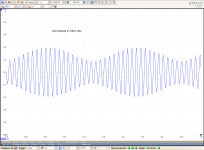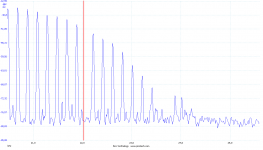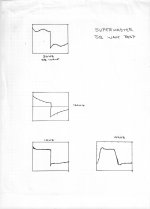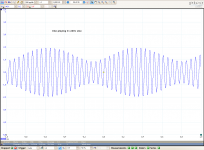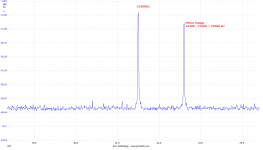George, take your time. Family is more important than some electronic oriented site full of guys with a couple of loose screws (myself included)Elektroj I am sorry I haven’t done the sinus test. I devoted the day to my wife’s wish for travelling around some really beautiful places out in the countryside. The weather was so good, that saying no would equate to Dante’s 10th Circle.
George, it is an output from the sound card. In the past I did some tests with CD players with 21kHz sine and white noise. It also showed transition area issues.
Good thank you.
Hm, noise. Another good idea.
full of guys with a couple of loose screws
elektroj, please mind the nut on the floor (it’s mine)
George
Thanks Esperado and DVV for your inputs.
I am thinking that many here are probably fairly forgetful of what analog masters do have for extended high frequency response. No, it is not perfect, but BETTER than any CD, even with commercial 15 ips recordings.
With 30ips mastering, the response could be as high as 40KHz or more, with a risetime of approximately 10us. I measured it myself.
If you get into the design of the reproduce stage of an analog recorder, you often find a 2pole, slightly resonant filter, at 20KHz or so in commercial models. It was deliberately contoured to fill in the scanning loss of the reproduce tape head to keep the frequency response flat out to 20KHz or more. The actual transient response was much closer to the original than any CD.
However, advanced analog mastering recorders that could make 30ips recordings, would use a different reproduce stage, without the resonant filter ( usually made from an added cap across the reproduce tape head), and achieve a flat frequency response to beyond 40KHz. In any case, virtually all analog recordings made at 15 or 30ips could have a much better HF transient response than any CD. The closest approximation today in digital is either 24/96K or SACD. Just look at the square wave responses of these recordings and compare them to CD. YES, it can be measured, but just listening is usually enough proof.
I am thinking that many here are probably fairly forgetful of what analog masters do have for extended high frequency response. No, it is not perfect, but BETTER than any CD, even with commercial 15 ips recordings.
With 30ips mastering, the response could be as high as 40KHz or more, with a risetime of approximately 10us. I measured it myself.
If you get into the design of the reproduce stage of an analog recorder, you often find a 2pole, slightly resonant filter, at 20KHz or so in commercial models. It was deliberately contoured to fill in the scanning loss of the reproduce tape head to keep the frequency response flat out to 20KHz or more. The actual transient response was much closer to the original than any CD.
However, advanced analog mastering recorders that could make 30ips recordings, would use a different reproduce stage, without the resonant filter ( usually made from an added cap across the reproduce tape head), and achieve a flat frequency response to beyond 40KHz. In any case, virtually all analog recordings made at 15 or 30ips could have a much better HF transient response than any CD. The closest approximation today in digital is either 24/96K or SACD. Just look at the square wave responses of these recordings and compare them to CD. YES, it can be measured, but just listening is usually enough proof.
Another "square", 100Hz. But I am afraid that some have not realized yet that any products above Fs/2 in a digitally processed signal are faulty and that they are only creating issues. We cannot directly compare analog squares and digital squares. What is OK with analog is wrong with digital.
Comparing analog (tape) with PCM, the only "advantage" of analog is visual shape of square response. All else is worse (noise, amplitude response flatness, distortion, dynamic range). And the square looks better only visually, in fact it reflects amplitude roll off. Take analog Butterworth maximally flat amplitude filter and you'll get overshoot and ringing as well.
If someone insists on good looking digital square, go SACD DSD.
Comparing analog (tape) with PCM, the only "advantage" of analog is visual shape of square response. All else is worse (noise, amplitude response flatness, distortion, dynamic range). And the square looks better only visually, in fact it reflects amplitude roll off. Take analog Butterworth maximally flat amplitude filter and you'll get overshoot and ringing as well.
If someone insists on good looking digital square, go SACD DSD.
Attachments
Last edited:
Hey Arny....
Psssssst....

Dan.
Read more at Great minds discuss ideas; average minds discuss events; small minds discuss people. - Eleanor Roosevelt at BrainyQuote
Psssssst....

Dan.
Read more at Great minds discuss ideas; average minds discuss events; small minds discuss people. - Eleanor Roosevelt at BrainyQuote
Another "square", 100Hz
What causes the missing odd and why the train of harmonics ends in this way?
George
like the rest of US, you tend to read what you want to read
Freudian slip
(1) Just plain outperform the 9600 as a recorder. Better SNR, double the max sample rate, etc. etc.
(2) Do listening tests without bothering with CDs, etc.
And while doing this sort of thing may be new to some, I've been enjoying it since around Y2K. That is what, about 16 years now? Do try to keep up! ;-)
I have zero interest in building a case for keeping CDs except to meet legal and ethical requirements while enjoying the music.
I have had a portable digital recorder that does up to 24/96 recording from phantom powered microphones long enough and used it often enough to have had to replace its lithium cell...
Marsh, you badly misjudge me on many grounds, probably because I'm so far ahead of you with digital audio technology that you can't see where I am! ;-)
I did not mean to indicate you were lacking in some way. just making a point with the 24/96 vs CD. The old ML-9600 work horse has mastered a lot of CD back in its day. Probably many of the CD I have.
I too have portable 24/96 recorders. i too using audio and video streaming. I do video streaming at UHD/3D in Bangkok with 4K. I too have music files on computer and portables. I too have played with 'sound cards' So, I too havent missed too much. Most all of these can out perform a CD. I have a large investment in Blues music.... on CD. Not much of it sounds very good. I have not bought a CD in so long I cant remember when i last bought one..... because of its sound.
Dont worry, I have not assumed what you have done or not.
THx-RNMarsh
Last edited:
This is another common issue. DAC playing 21.5kHz sine. Input data are OK, but the DAC filters are unable to make a proper reconstruction of the signal close to Fs/2. The result is modulated signal.
Hi,
This, IMO, is another manifestation starting to show the affect of approaching the 'Gibbs' condition.
THx-RNMarsh
... That out perfrom analog tapes in all aspects: distortion, noise, cost, physical volume, retention time, ease of use, sharing and distribution ...The closest approximation today in digital is either 24/96K or SACD.
No need to talk and fight here about CDs any more, CDs had passed like LPs ...
This is another common issue. DAC playing 21.5kHz sine. Input data are OK, but the DAC filters are unable to make a proper reconstruction of the signal close to Fs/2. The result is modulated signal.
Certain filters, maybe. And, certain graphics, indeed. The modulation need not appear in the reality. The issue is the steepness of the filter modelled. Would be the steepness infinitely high, it means the ideal brickwall filter, then the reconstruction would be O.K. Unfortunately, such filter has an infinitely long response (or settling time, if wanted). This is not a problem of implementation, but the "signal mathematics", and it cannot be overcame by any clever implementaton. Nevertheless, the better filter, the better reconstruction. The appropriate oversampling fairly eliminates the "modulation".
I did not mean to indicate you were lacking in some way. just making a point with the 24/96 vs CD. The old ML-9600 work horse has mastered a lot of CD back in its day. Probably many of the CD I have.
THx-RNMarsh
CD's are not mastered that way. They are prepared as digital files set to the mastering facility in a specific format with the table of contents and written to a glass master. The extracted data on a CD may be the same but the creation is done usually with a digital work station (Sonic Solutions was the most popular or so they told me). Early on the files were sent on a Sony Umatic videocassette. Later they may be sent on a CDR and today most likely over the internet. I believe the only "direct to CD' projects ever were done by Reference Recordings and were an incredible PITA to do (the table of contents had to be done before the recording so there was no option to have anything shift in time or pace.
"NOTE: Hyman's solo performances, encoded on the Bösendorfer computer reproducing piano, were played back live for our microphones. For the Direct-to-CD (DCD) editions, the digitized signal was transmitted via microwave to the CD glass master as the music was happening. No recording tape of any kind was used, nor was the digital bitstream corrupted at any stage by copying or editing. The very digits generated at the recording session are engraved on the finished DCD." (I think everyone involved was laughing over the "very digits" line but audiophiles are more inclined to buy if its really hard to do.
Last edited:
It was a very nice recording.CD's are not mastered that way. They are prepared as digital files set to the mastering facility in a specific format with the table of contents and written to a glass master. The extracted data on a CD may be the same but the creation is done usually with a digital work station (Sonic Solutions was the most popular or so they told me). Early on the files were sent on a Sony Umatic videocassette. Later they may be sent on a CDR and today most likely over the internet. I believe the only "direct to CD' projects ever were done by Reference Recordings and were an incredible PITA to do (the table of contents had to be done before the recording so there was no option to have anything shift in time or pace.
"NOTE: Hyman's solo performances, encoded on the Bösendorfer computer reproducing piano, were played back live for our microphones. For the Direct-to-CD (DCD) editions, the digitized signal was transmitted via microwave to the CD glass master as the music was happening. No recording tape of any kind was used, nor was the digital bitstream corrupted at any stage by copying or editing. The very digits generated at the recording session are engraved on the finished DCD." (I think everyone involved was laughing over the "very digits" line but audiophiles are more inclined to buy if its really hard to do.
CD's are not mastered that way. They are prepared as digital files sent to the mastering facility in a specific format with the table of contents and written to a glass master. The extracted data on a CD may be the same but the creation is done usually with a digital work station (Sonic Solutions was the most popular or so they told me). .
Thanks for the current update on making CD's. I've read of such for prep for mass production... and DAW are very flexible and powerful tools for editing and finishing before being written to a glass master. The direct to glass is interesting at that period of time.
The files stored on the ML-9600 are those type files. The local burning of a CD allows the person to make a copy of what is going to be heard for small scale distribution. ... like to musicians, producer to get approvals etc. It can also be played back without burning a CD. They could also be sent in file form many ways... over the internet etc. for possible further processing (DAW). But certainly they would not use the machine for mass production of CD's.
Note this is a machine used years ago and no longer in production. The data and CD format (Redbook) is the same for the purposes of finding out what happens to a signal from ADC to CD playback and comparing 16/44 to 24/96 and is the only reason i got it. Now, it is being used for playback only until the newer design OPPO player arrives this week and I test it also. I am looking for the HF noise it may have. I have also looked at the HF of other Cd players and DVD players. No doubt it will have the same roll-off at 10KHz also.
For HD Mastering, no compression and major EQ etc is allowed by those companies I download from. They have their own specs for mastered files to be sent to them. The files are remastered for highest fidelity. A slightly differnt and more direct path to me at 24/96+ are these HD download files from those HD masters. It would be interesting to find out more about HD masterfiles from these internet download sources. Do you know much about it?
THx-RNMarsh
Last edited:
Certain filters, maybe. And, certain graphics, indeed. The modulation need not appear in the reality. The issue is the steepness of the filter modelled. Would be the steepness infinitely high, it means the ideal brickwall filter, then the reconstruction would be O.K. Unfortunately, such filter has an infinitely long response (or settling time, if wanted). This is not a problem of implementation, but the "signal mathematics", and it cannot be overcame by any clever implementaton. Nevertheless, the better filter, the better reconstruction. The appropriate oversampling fairly eliminates the "modulation".
I am sorry, but you did not get it, maybe I was not explaining enough.
1) it is not a result of graphics and it is no simulation. It is an output of sound card digitized with a very fast digitizer. The "modulation" in time domain is another view to twin-tone in frequency domain. The twin-tone is a result of mirror image spectral line, which is 44.1 - 21.5 = 22.6 kHz. This is a result of not enough high steepness of the reconstruction filter. Please check the attached images.
2) everything you wrote about filters is OK, but it is a pure theory. I have measured dozens of CD players and sound cards and I am showing an usual and common behavior of real implementations.
3) it is an Oversampling DAC, quite up to date (AK).
Attachments
Last edited:
- Status
- Not open for further replies.
- Home
- Member Areas
- The Lounge
- John Curl's Blowtorch preamplifier part II
